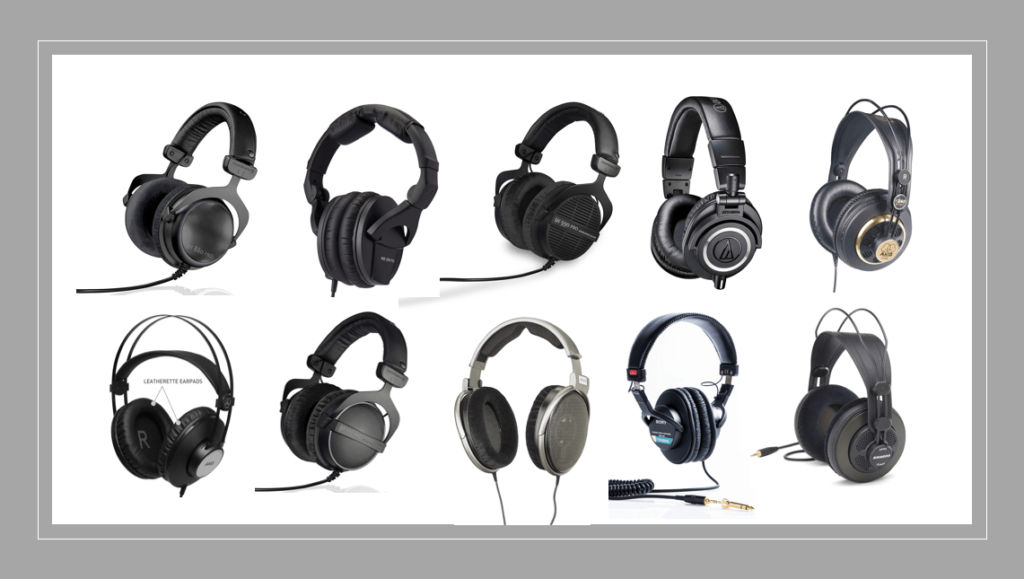
When it comes to studio work, a quality pair of headphones is a must-have equipment. Headphones serve as aids for recording as well as editing and mixing. You’ll use headphones primarily for recording, especially when overdubbing. Headphones are essential when you want to avoid bleed and use them for hearing a previously recorded track.
For home studios, headphones also aid in mixing when speakers are not a practical option. Further, they are needed for editing, as you get a far more accurate sense of your L-R pans in studio quality headphones than, say, the earbuds that come with your cell phone. Headphones will let you hear the quiet parts of your track that speakers or monitors can miss.
In this article, we will discuss the types of headphones, as well as present our choices for the best studio headphones on a budget.
Types of Headphones
Before purchasing a home studio headphone, you should be familiar with the three main types to choose which is best for your needs. Your choices are open-back, semi-open, and closed-back headphones.
Open-back Headphones
Open-back headphones are designed to allow air to pass through the ear cups and on to the speaker. Pressure doesn’t build up and affect your sound. Meaning, you don’t experience those little echoes within the headphones. Thus open-back headphones give you a clear and natural sound.
However, the open design also means the headphone doesn’t block outside noise. So, you can expect to hear the sounds around you. The opposite also applies. Anyone in your proximity can hear what you are listening to.
While open-backs can’t do double duty as personal headphones for the office, they are well-suited for home use and the studio. They are perfect for listening to high-quality audio files and critical listening. They are often the professional’s first choice for mixing, mastering, and editing.
Closed-back Headphones
Closed-back headphones are designed just as the name implies. They are sealed around the back, which means they send sound to your ear with no leaking. Thus, closed-backs block out the outside noises as well. However, you may not experience as natural a sound as open-backs.
You do get some slight echo in bass notes with this type of headphone. Some users complain that the headphones feel hot after extended wear. Nonetheless, these do well for commuting or listening to music in the office.
For the studio, they are great for listening to yourself while you record. Your mic won’t pick up stray sounds coming from your headphones.
Semi-open Back Headphones
The third category is the semi-open back headphones. This variety does have a closed-back, though it’s not entirely sealed. Some air passes through the chamber, which means some sound leaks out as well. Likewise, outside noises make their way in.
So, semi-open headphones are suitable for casual listening at home and can also be used in the studio for mastering and editing, but open-back provides a better more clear sound.
In the next section, we will review our picks for the best studio headphones on a budget.
The Top 10 Best Studio Headphones on a Budget Are:
- Samson SR850
- AKG Pro Audio AKG K72
- AKG K240STUDIO
- Sony MDR7506
- Sennheiser HD280PRO
- Audio-Technica ATH-M50x
- Beyerdynamic DT 990
- Beyerdynamic DT 770 PRO
- Beyerdynamic DT 880
- Sennheiser HD 650
Next up are our reviews for each one of the best studio headphones you can buy organized in ascending order from low to high price.
1. Samson SR850 Studio Reference Headphones
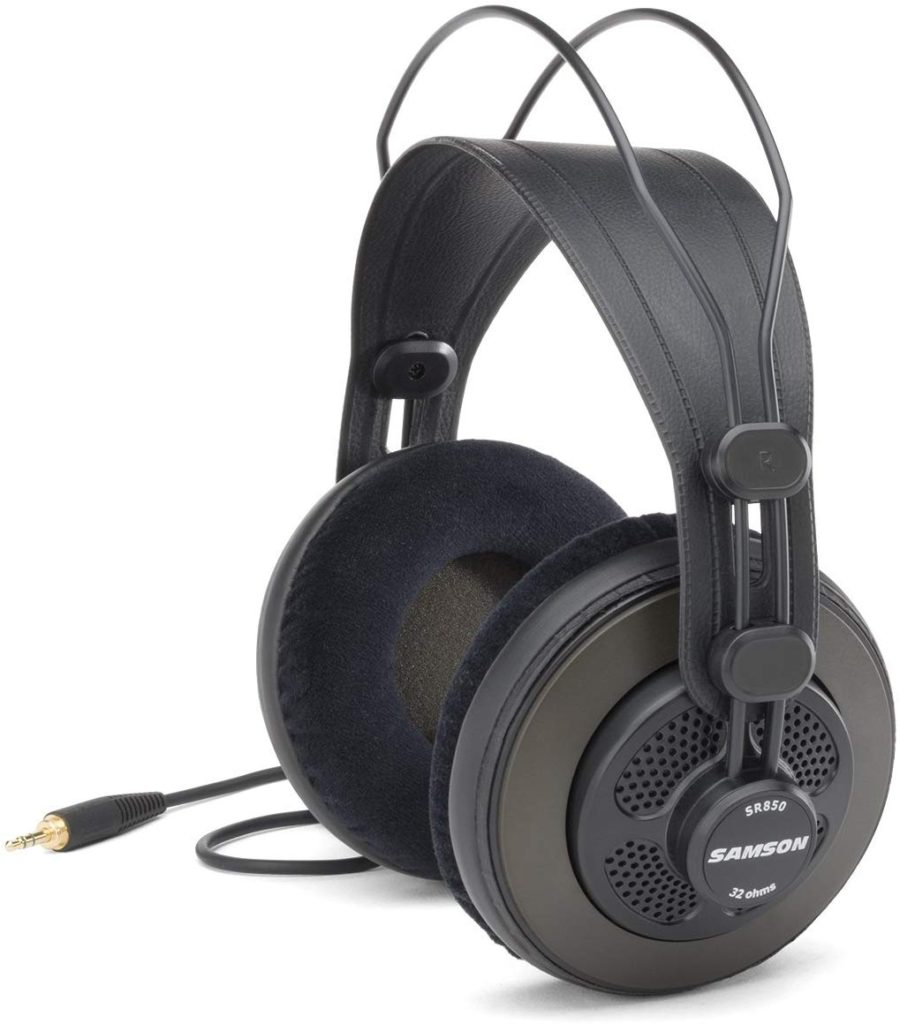
The Samson SR850s are semi-open-back headphones that have been designed specifically for professionals. With a frequency response range of 10 Hz-30 kHz and 50mm driver, you get superior sound for a surprisingly low price.
They are just the right headphones for mixing and playback, giving you a wide sound stage with correct bleed. With these studio-quality headphones, you get the best stereo imaging for your money.
Sound Quality
Because they are semi-open, isolation is minimal. Though they won’t completely block sound the way closed-back headphones do, they do block out an ample amount of noise. The same goes for leakage.
The SR850 headphones have a solid low end that should satisfy just about anyone, though diehard bassheads will want to add an EQ. They extend down to 20hz with no issues and provide the right amount of rumble and impact. The sound is textured and precise and doesn’t leak into the mids at all.
As for the mids, they are smooth, clear, and realistic. Again, amazing sound for the price. The same goes for the highs, which you’ll find are also clear and transparent with no sibilance.
Comfort Level
The headband on the SR850 is comfortable and adjusts to fit your head. The headband is also flexible so that it self-adjusts to your head. It’s not too snug, though someone with a larger hat size may find it pinches. The 1/8 and ¼ inch, gold-plated adapters also come in handy.
Build Quality
These headphones are built to last. While the design is best described as no-frills, the materials are durable. The flexible headband is tough and just about unbreakable. Likewise, the sound quality they deliver will not disappoint.
Pros and Cons
One of the best advantages of these headphones is the low price point, perhaps making the Samson SR850s the best studio headphones on a budget. They offer equal, if not superior, sound reproduction for monitoring, recording, and mixing, editing, and mastering when compared to more expensive models.
Also, because they are semi-open, you’ll get the transparent soundstage discussed above. On the downside, they do have the expected drawbacks associated with open-back headphones, which are ambient noise and leakage.
2. AKG K72 Pro Audio Studio Headphones
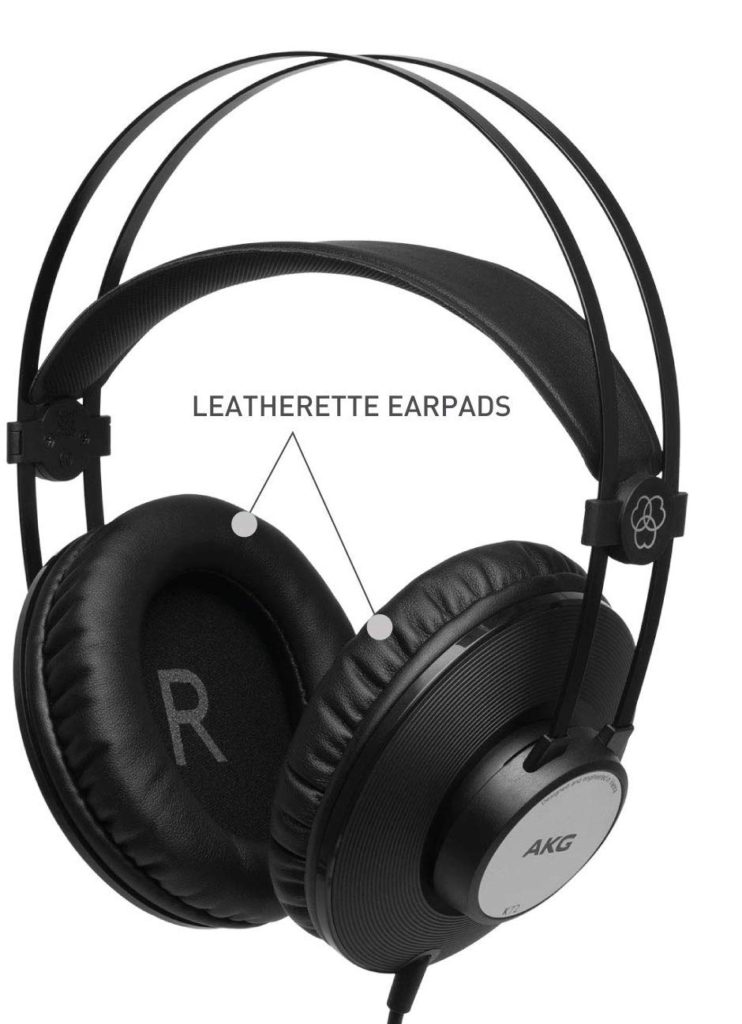
The K72 closed-back headphones are one of AKG’s lower-cost headphones you can purchase for $50 or less. They are designed for monitoring, recording, and mixing. The design includes high-grade, 40 mm drivers that give you precise and detailed sound, which of course, aids in recording and mixing.
Sound Quality
Despite their surprisingly low price, the AKG K72 is designed with professionals in mind, especially for studio monitoring and mixing. The frequency range is 16 Hz – 20,000 Hz, and the drivers give a detailed, crystal clear sound that you don’t expect from a $49 set of headphones.
We do think that the mid frequencies are slightly over-emphasized, and the sound is not as neutral as we’d hoped for monitoring headphones. However, this may not be noticeable, depending on the type of music you are mixing. For the most part, you’ll get a very natural sound.
As for the soundstage, that is on par with what you get with closed-back headphones, no better or worse than comparable models. Overall, if you’re shopping on a budget, you’ll be happy with the K72. They offer high sound quality for a low price, which ranks them among the best studio headphones on a budget.
Comfort Level
Comfort is a definite plus for the AKG K72. These over-ear headphones have very lightweight earpads and a soft headband that self-adjusts for a comfortable fit. Each of the fabric pieces is replaceable as well.
The circumaural earpads are large and completely encircle your ears rather than putting pressure on them like other headphones often do. Thus, the K72 are comfortable and easy to wear for just about everyone, including adults with larger ears and a wider crown.
Build Quality
Even with the low price, AKG does not spare quality. The K72 headphones are built well and hold up to extended use. The design is over the ear with a closed back. While they don’t have the sleek design of more expensive headphones, they come through in performance.
The K72’s cable is non-detachable, of adequate length, and single-sided. This configuration is reliable and convenient for those of us who move around in the studio. As mentioned above, they provide comfort during use, which makes up for the lack of aesthetics in the design.
Pros and Cons
The most significant benefit of the K72 is the price. AKG didn’t spend a lot of time on the aesthetics for a reason. They saved it for quality in terms of sound. The studio-grade drivers and other components create a clear sound that comes through a lightweight frame.
The result is a set of headphones suitable for professional use in the studio that also happen to be extremely comfortable for those long sessions in front of the mixing board.
Now, some may find the plain design to be an unattractive feature. Also, the sound is neutral, but with a slight emphasis on the mids. Thus, you may find the overall sound to be colored and not completely neutral. While it’s all a matter of personal preference, these may be considered negative features.
All in all, the AKG K72 is one of the most affordable studio headsets on the market. Designed for studio monitoring and mixing, they are comfortable and deliver clear sound.
3. AKG K240STUDIO Semi-Open Studio Headphones
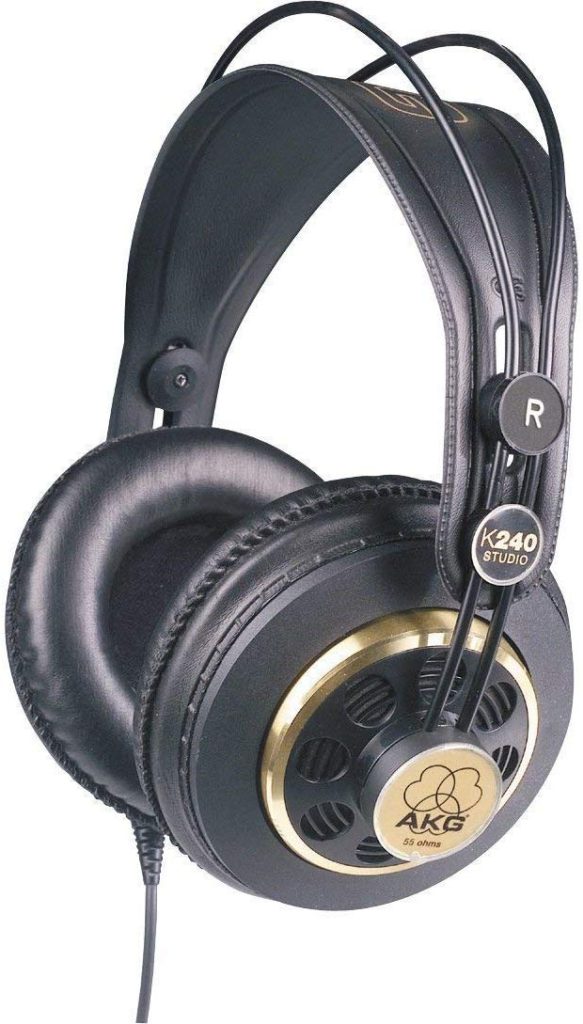
The AKG K240 Studios are semi-open, over-ear headphones that get the job done for an affordable price. They come in a simple package and a 10’ detachable mini XLR cable and a 6.3mm adapter.
The K240 sounds great, and the design is detailed enough to be comfortable. The mids and highs are exceptionally clear. Though, they don’t have a lot of power to the bass, which may put some users off.
Sound Quality
As we mentioned, the K240 headphones have sharp, clean mids and highs. Vocals and guitars come through with perfect clarity. The same goes for wind instruments. The detail, especially on the higher notes, is a quality you’d expect from a much more expensive model. The semi-open design creates an airy, spot-on sound stage.
Comfort Level
Even though the visual design of these headphones is plain, they are quite comfortable to wear. For example, the adjustable head strap has minimal padding. However, that makes the headphones light and easy to custom fit. They conform your head well and hug your ears lightly,
The retro-style, oversized earpads are cushioned and comfortable, adding to the comfort level significantly. The earpads surround your ears and apply gentle pressure, making the sound experience all the better. You can listen for hours without feeling sore.
Build Quality
The K240 has AKG’s tried and true Varimotion design. It has two dynamic transducers, which gives it a frequency response of 15-25,000Hz, and an impedance of 55 ohms. The sensitivity comes in at 91dB. Further, the total harmonic distortion is less than 0.3 percent, with a max input power of 200mV.
These headphones have a fun retro look combined with modern construction. They feature large, semi-open ear cups that are a distinct throwback to the 1970s when headphones had the oversized earcups. The black and gold color scheme adds to the old-school look.
Pros and Cons
The K240’s excellent build quality and retro look appeal to all generations of users. Additionally, the extra cushioning and overall fit make it more comfortable than most semi-open models.
The sound quality is on par with the top-of-the-line studio headphones. The sound remains true and natural, including the bass. The highs are especially well-presented, which is excellent for vocal clarity, acoustic tracks, and even dialog tracks.
One disadvantage may be the length of the cable. In this instance, the cable may be a bit too long for personal use. Also, there are no cable controls, which may be problematic if you’re using the headphones with a smart device. Overall, these are excellent quality studio headphones for the price.
4. Sony MDR7506 Professional Large Diaphragm Headphone
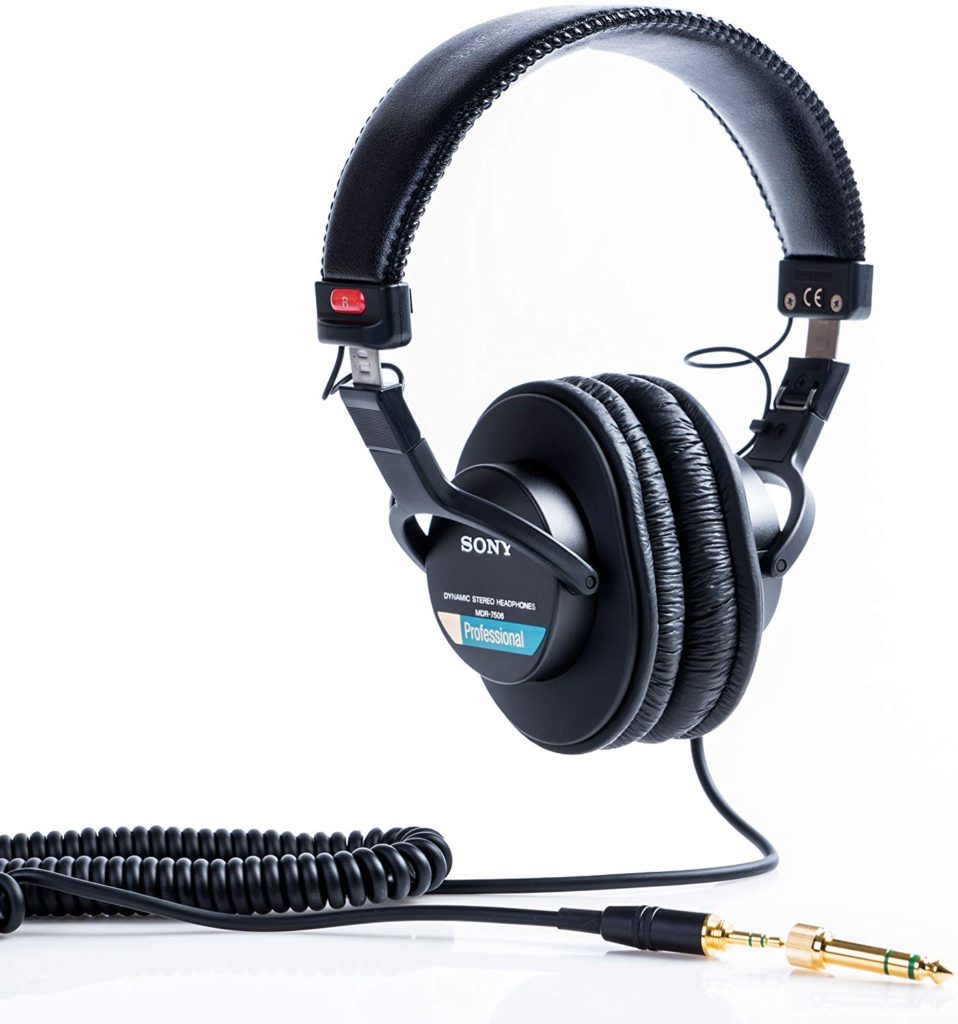
Sony’s MDR7506 Headphones are the top-selling product on Amazon under the Shakers category. They are closed-ear for sound isolation and have a frequency response of 10Hz-20 kHz. These headphones also feature 40 mm drivers and neodymium magnets for enhanced quality, as well as a 9.8’ cord with a gold-plated plug.
Sound Quality
Sony designed these headphones for audio production, and they deliver as promised. The MDR7506 produces a true sound at each frequency range. That includes true sound at the mids and highs, which you don’t get with lesser quality headphones, especially models intended for casual use.
We do feel, however, that these headphones struggle just a bit when it comes to the low-end notes, as they don’t appear to be blocked at all. Then again, many over-the-ear models have this issue. In short, they don’t do as well when it comes to bringing the bass sounds to the front.
Comfort Level
The MDR7506 has extra headband padding for your increased comfort for extended use. They are also lightweight at about 8 ounces. To store, just fold and fit inside the soft case. The extra-long cord is an excellent convenience, giving you more freedom to move as you work.
Build Quality
The MDR7506 are a bit pricier than some of their counterparts, though Sony’s professional quality makes them well worth the extra price. This makes them an excellent choice for recording and mixing in the studio as well as general listening.
Pros and Cons
The reviews speak for the quality and other advantages of the Sony MDR7506. They are a solid pick for casual listening as well as studio work. In addition, Sony’s reputation for quality ensures that these headphones are durable and deliver as promised.
The closed-ear design gives you privacy and blocks exterior noises well. The only downside to this is, of course, if that you can fatigue after wearing any closed-ear headphones for a prolonged period.
Overall, these headphones serve your recording purposes well, the sound quality is excellent, and the design is quite comfortable.
5. Sennheiser HD280 PRO
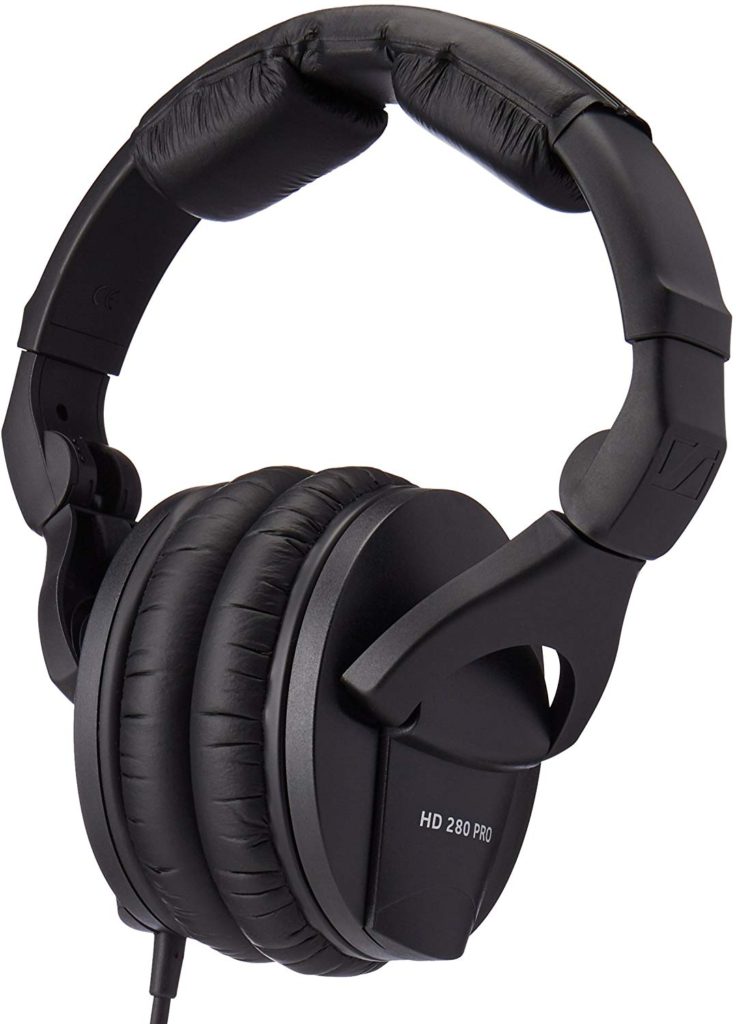
This HD 280 Pro is the new model by Sennheiser, which are closed-back headphones for professional monitoring use. Though, these are well-suited for many applications because of the flat frequency response, low impedance of 64 ohms, and its high sensitivity.
Unlike portable headphones, these have no-frills, as the design focuses on sound performance and comfort only. In this regard, there’s no difference between the older model and this newer one. The only real difference is in the headband (more on that later).
Sound Quality
The closed, circumaural design of the HD280 PRO makes it excellent for listening while in a loud environment, in the studio, on your morning commute, or around the home. Remember that these are budget headphones, so they aren’t top-of-the-line, though they have good sound quality for professional-level use.
The bass is well-balanced for critical listening, though an avid basshead would find the bass lacking for his or her purpose. As for overall sound reproduction, the highs and mids are well-balanced, crisp, and blend well over a variety of genres. If you are a DJ, musician, or sound engineer, you’ll appreciate the sound signature these headphones deliver.
Comfort Level
The HD280 PRO has a snug fit with comfortable, soft leatherette padding around the ears. The ear cups cover your entire ear for a great seal without adding uncomfortable pressure. The tight seal provides sound isolation and better bass delivery. The closed-back also prevents sound leakage so that you can use it in public spaces with no worries.
The headband has the same padding to add to your wearing comfort. Further, the earcups have a hinge and swivel attachment that gives you added flexibility during use. DJs especially like the swivel design, as it allows them to listen with only one ear cup when needed.
Build Quality
The great thing about these headphones is that they offer professional quality, a durable design, and they are great for everyday use as well as the studio.
The heavy-duty, coiled cable holds up well, providing ample strain relief. Note, however, that you will have a bit of a pressure issue when you use the included 3.5mm jack. Should the headphones somehow outlast the cable, you can order a replacement (though not for the 3.5mm jack). You can order replacements for the earpads and headband pad as well.
While the frame is plastic, for the most part, they are nonetheless solidly built. And, the collapsible design adds to the overall user experience.
Pros and Cons
As we stated, the HD 280 Pro headphones provide superior noise isolation and reduce ambient noise due to the closed design. The overall build is truly professional-grade and holds up to heavy use. For studio work, you can count on these for clean audio performance, even when monitoring at lower volumes.
The only drawback we can see is that the coiled cable is a bit heavy, which can strain the connectors over time. That, and the extra padding can make a tight fit for those with larger head sizes, though that can be said for most headphones. Overall, the HD 280 are affordable recording and mastering-suitable headphones.
6. Audio-Technica ATH-M50X
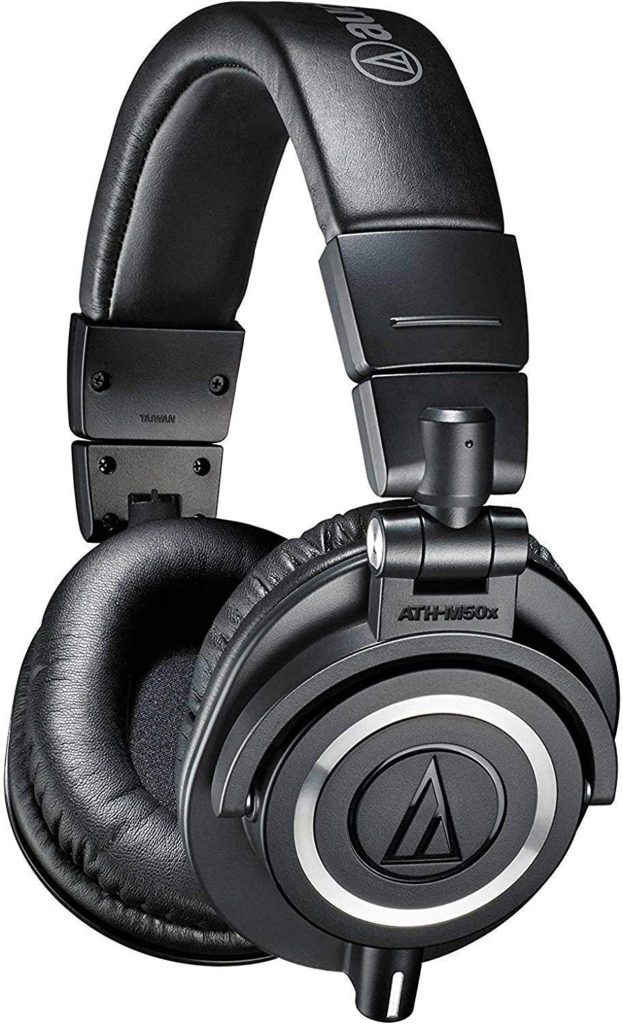
ATH-M50X by Audio-Technica were closed-back DJ headphones redesigned to suit a wider audience. They are rather chunky compared to others, but that also means they deliver a big sound for professional studio monitoring. This redesign does not, however, include Bluetooth capability or active noise cancellation like casual user models. They are simple, wired headphones.
Take note that the M50X doesn’t have a super-balanced sound typical of headphones. Rather, Audio-Technica designed these to function like professional studio monitors. They sound great but aren’t completely neutral. So, you may not want to mix with these headphones, but they are spot-on for monitoring.
If what you need are headphones with a great soundstage and powerful base, all for a great mid-range price, you have a solid pick with the ATH-M50X.
Sound Quality
As we stated, the ATH-M50X are monitor headphones, meaning they are more neutral than most monitors, but not as entirely neutral as high-end studio headphones. You’ll hear a small emphasis on notes in lower frequencies.
The upper frequencies sound great, especially when listening to classical music and any arrangement with wind instruments. The strings are airy and float through the mids and highs with little to no harshness.
You may also find that the bass is overemphasized, depending on the music sample. Overall, though, your sound is clear and crisp.
Comfort Level
The plastic headband is surrounded by plush padding that makes these headphones comfortable to wear. The ear cups rotate a full 90 degrees, which means they can lay flat around your neck when you’re not using them. It also adds to your comfort during use.
The padding doesn’t breathe well, however. So, you may end up taking them off from time to time to give your ears some air.
Build Quality
Both the design as well as the build on these headphones are stellar. Aesthetically, they are stylish but not overdone. They often come in different color options, though all the selections are subtle rather than flashy. They are also sturdy in construction, made up of lightweight but strong plastic.
Pros and Cons
These Audio-Technica studio headphones are built exceptionally well and have a layered, balanced sound with solid bass. They are also comfortable for the most part due to the cushioned ear cups. They also come with three detachable cords, which gives you great versatility.
Remember that these aren’t designed for use with mobile devices. So, you can’t use them to make calls or switch from cords to Bluetooth.
For the price, the ATH-M50x is an improved version of their well-known predecessor and one of the best pairs of monitoring headphones you can buy in their price range.
7. Beyerdynamic DT 990 Headphones
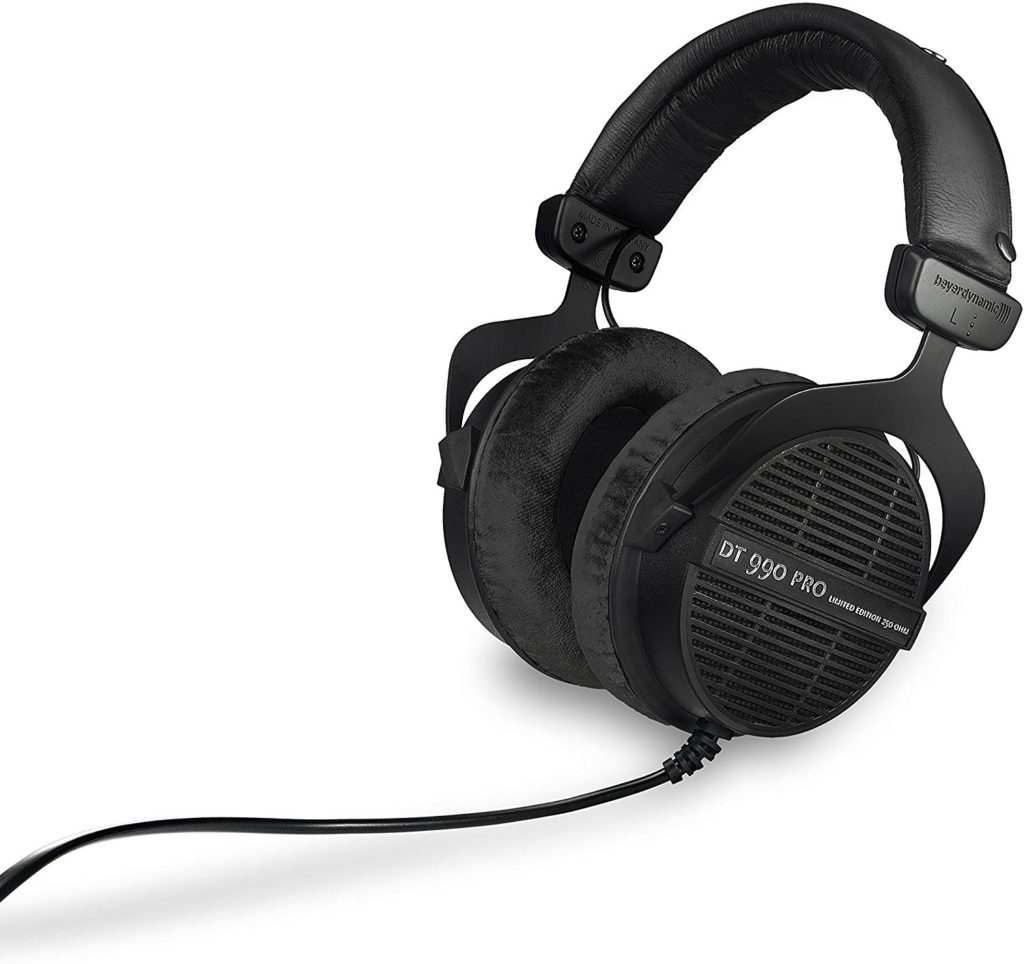
The DT 990 Pro is an “old school,” open-back studio headphones, whose design hasn’t changed since the 1990s. Despite the older design, the DT 990 is a staple in man studios. Users often name it as a reliable, mid-price point studio headphone.
Sound Quality
If you’re familiar with DT 990’s sister headphones, the DT 770 and DT 880, you’ll note that they all characteristically exhibit some excitement at the low and top end. This is called a U-curve. At around 6.5kHz, a treble iceberg begins that makes it difficult to note instrument overtones.
For this reason, we feel it would be difficult to use the DT 990 Pro for mastering, even though the manufacturer recommends them for this purpose. The highs do make it easier to pick out some issues you’d find in any mix. Though, overall, they create more work for the engineer.
Comfort Level
These Beyerdynamic headphones are comfortable, albeit somewhat tight on the head. The ear cups are well-padded and fit comfortably around your ears. Though, we find that the headband is rather rigid, which makes the headphones tighter. After an extended listening session, they become uncomfortable.
Build Quality
The DT 990 Pros are sturdy and built well. The headband has a tough metal frame that can handle the extended stress that comes with use. While the open-back ear cups are plastic, they are dense and stand up to wear and tear.
Pros and Cons
The DT 990 headphones are durable due to their sturdy build. They function as formidable open-back headphones and provide wonderful, open audio reproductions. Finally, the overall design is solid and well-padded at the ear cups.
Some of the disadvantages to these headphones have to do with the open-back design. They leak sound and provide little isolation from the surrounding ambient noise. Another drawback is that they are tight across the head, which may turn off some users, especially those who will be wearing them for extended periods in the studio.
Overall, the DT 990 PRO headphones are excellent headphones for critical listening. They provide great audio reproduction. Though, the open-back intended for casual use. By design, they leak sound even at lower volumes.
8. Beyerdynamic DT 770 PRO
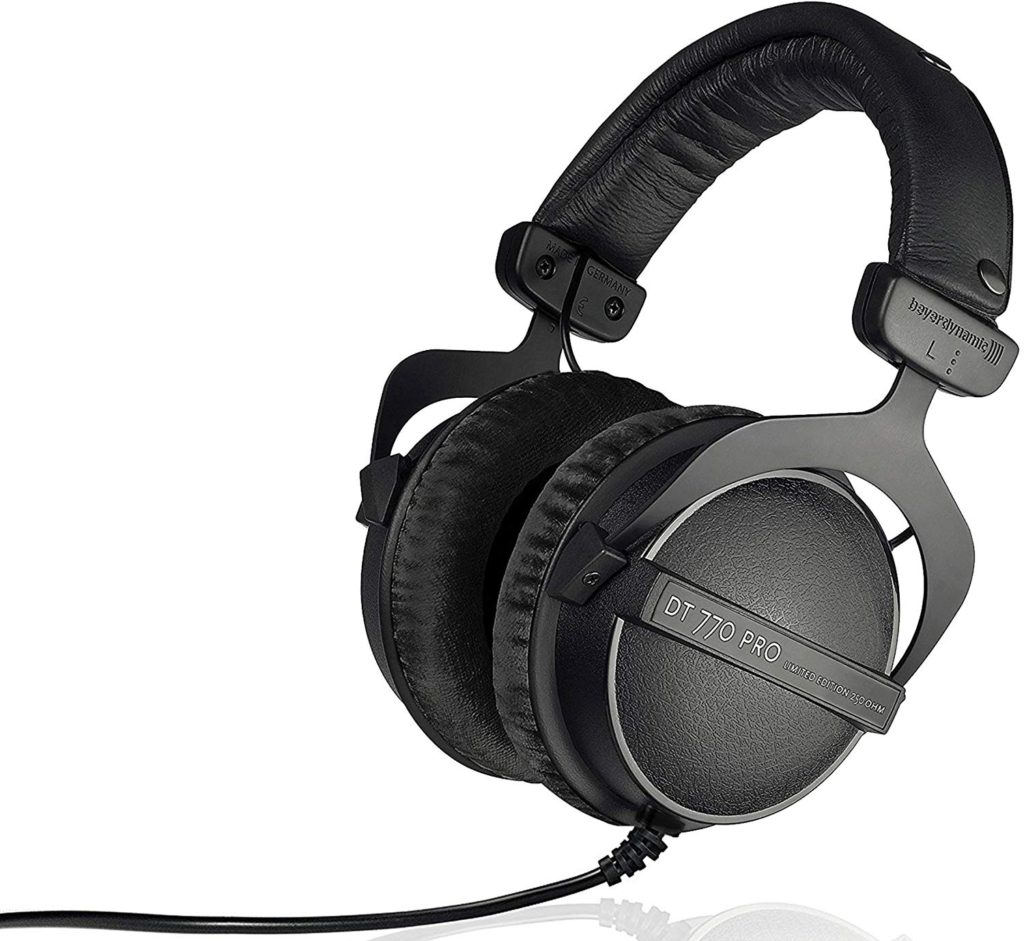
The original version of the closed-back DT770 debuted back in the 1980s and has been revered ever since. Beyerdynamic designed them for professional studio use and recording as well as for the stage. This model comes in three variations, 32 Ohm, 80 Ohm, and 250 Ohm.
Sound Quality
The DT770 has a distinct sound, with a swift response rate that makes them great for performance. The 250-ohm variant has an extremely bright sound. Thus, the mids and highs are a touch more vibrant. All the variants deliver a crisp, precise sound without too much bass.
However, despite pointing out the fact the mid-range frequencies on these headphones are on the brighter end, they are not all that aggressive. Overall the projected balance between frequencies is harmonious and not harsh in the least.
Comfort Level
The DT770 Pro has thick padding on the ear cups as well as a velvety covering to the headband that makes these headphones a pleasure to wear. The ear cups are wide enough to fit over your ears rather than press against them. You can adjust them to your head for the best fit. They isolate sound well, making them easy to use during recording sessions.
Build Quality
The build for the DT770 is solid. You will have these headphones for a long time. They are constructed with steel, neodymium magnets, and composite housing. As for aesthetic design, they have a bit of a retro feel, which we like. They recall the chunky look of the headphones sold with the 1980s Walkman.
Pros and Cons
What we like most about these headphones is that they are reasonably-priced, yet sturdy in construction. They sound great for any class of headphones, with good balance and neutrality across frequencies.
The only real downside to the DD770 is that the cable cannot be replaced because it’s not detachable. So, once that goes, you will have to invest in a whole new pair.
9. Beyerdynamic DT 880 Pro Studio Headphones
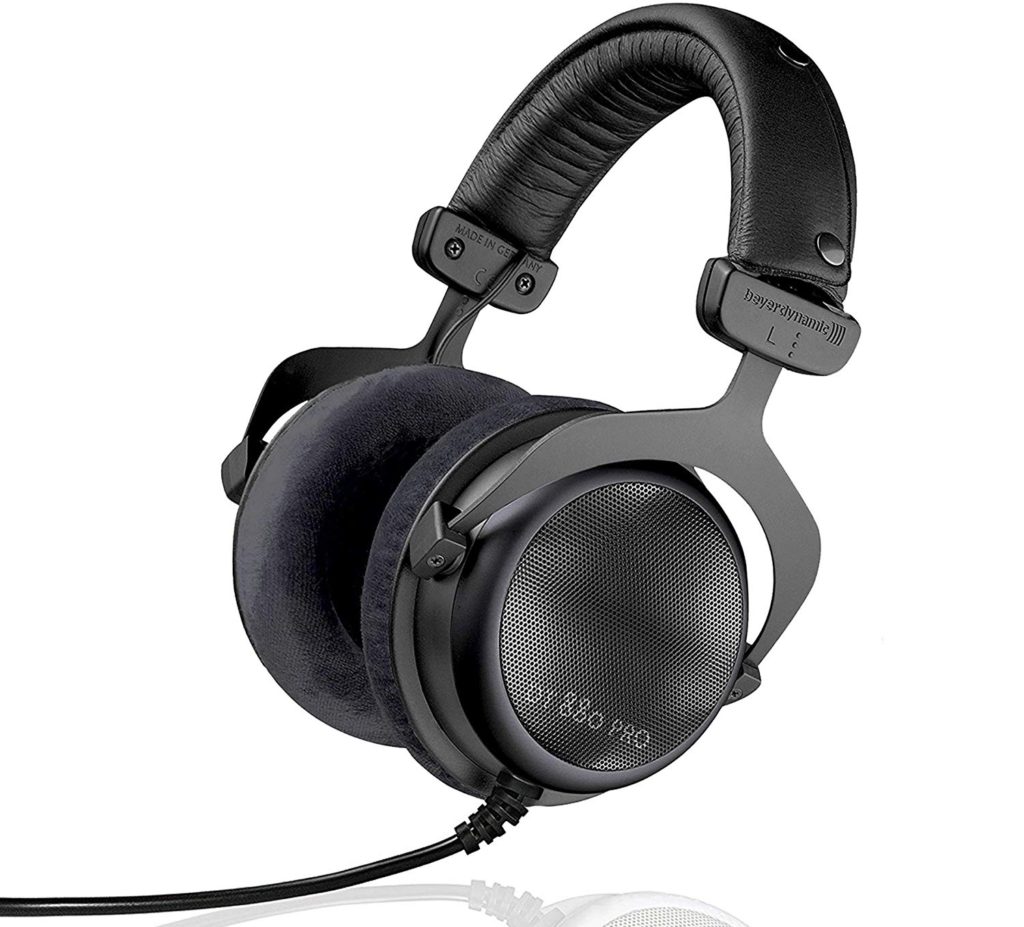
Beyerdynamic has a reputation for making quality audio tools for musicians and sound engineers alike. Yet, their headphones are appreciated by casual music lovers as well. The semi open-backed DT 880 is an excellent choice for anyone, professional or amateur, looking for a precise sound signature. These studio headphones are great for mixing and mastering.
Sound Quality
These headphones deliver clear, true sound for the most part. Each note comes through at the correct volume. You can go to the next price level up if you need more precision. Though, these perform higher than their class.
Some users report a bit of distortion in the low end, but only younger users will notice it and even then, only if they are looking for it. If you choose, you can equalize the sound if you feel you need to. Though, you’ll only need slight adjustments in volume.
Because of the open-back design, you won’t have any sound isolation. Of course, that means these are not portable headphones you can use in public spaces like the subway, office, or on an airplane.
Comfort Level
The headband is wrapped leather padding that attaches with buttons. Why? You can order replacements or alternate styles and fabric to customize the fit of the headphones. Beyerdynamic also sells replacement ear pads should yours wear out.
Finally, the velour earpads add to your comfort, especially for those who spend long hours at the mixing board. In addition, the long, coiled cable, which is 3 meters, gives you the freedom to move in the studio.
Build Quality
The DT 880 Pro is durable. They feature a matte chrome finish on the backside. The metal ear forks and band have a complementary matte black finish. The cable, which hangs from the left side, has a protective rubber shielding. These features strengthen the construction and extend the life of your headphones.
Because these headphones are semi open-backs, you won’t experience heat build-up during extended use. Note that you will, however, experience the sound leaks you’d expect from the open backs.
Pros and Cons
The DT 880 Pro performs extremely well. The semi open-back design gives you a delightful airiness and a sense of space during listening sessions. The comfortable fit with customizable options is an additional advantage.
As we mentioned earlier, the semi open-back ear pads do create outward sound leaks and don’t block all ambient noise.
Also, note that these headphones don’t work well with mobile devices. The cable has no inline remote, and the impedance levels don’t get loud enough when used with cell phones. The DT 880 is best suited for professional studio gear and stereo systems.
Overall, the Beyerdynamic headphones give you a spectacular listening experience appreciated by sound engineers, musicians, and music lovers with good stereo systems.
10. Sennheiser HD 650 Headphones
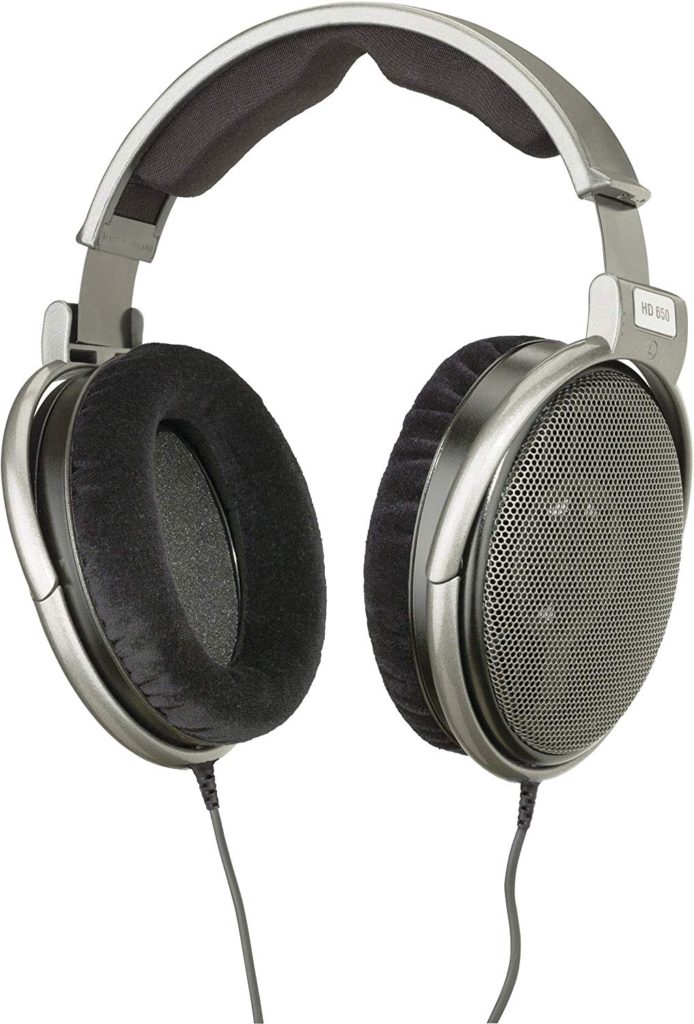
Sennheiser designed its HD 650 headphones for audiophiles and professional music producers. They are highly specialized, so much so that the average user may overlook some of the features. Sennheiser focuses on sound quality, meaning these headphones have high-quality sound drivers and an open-back design.
Sound Quality
Due to the precise design, the HD 650 headphones are dead-on accurate. They do not boost the low and high ends. However, you may find that the low end is extended more than your previous set of open-back headphones.
Compared to other open backs, the HD 650 is warmer and smoother, with a deeper base. Some users feel they lean towards too much warmth in that the highs are suppressed as compared to other models. Thus, those who prefer the warm sound find these ideal. In addition to the fantastic low end, the sound is precise. They have little to no distortion on woodwinds and vocals, making for a fluid midrange.
Comfort Level
The HD 650 has a soft, almost luxurious feel because of the extra-padded headband. The headband is made with a titanium and silver finish, along with ear cushions that have ample padding as well. Due to these materials, these headphones are bulkier and heavier than most, yet still very comfortable.
Build Quality
As we mentioned before, the drivers on this headphone are superior in that they have precise, balanced left and right tolerances. The construction includes computer-optimized neodymium magnets that serve to minimize distortion. Adding to the accuracy are voice coils, which are made of aluminum. They make the headphone accurate and give them a quick transient response.
The HD 650s’ Y cable is another sign of quality. This 9-foot cable is replaceable, which adds to the longevity of the headphones. It has a 1/4-inch plug and comes with a miniplug adapter.
Pros and Cons
As we have discussed, these headphones by Sennheiser are excellent for neutral listening. They provide a comfortable listening experience even during extended wear. And, the left and right channels are perfectly matched.
On the downside, they lack a bit of bass compared to closed-back headphones. Again, they are a bit too forward with winds and voice for some. Overall, however, they provide excellent sound for the studio. The price is a bit higher due to the quality, though the price point is competitive.
Overall, these headphones nonetheless fall into the category of best studio headphones on a budget due to the quality sound and construction. I hope that this post can help you choose the right headphone for your home studio. If you have any questions or comments please leave them below, thanks.